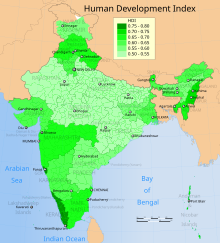
The Kerala model refers to the practices adopted by the Indian state of Kerala to further human development. It is characterised by results showing strong social indicators when compared to the rest of the country such as high literacy and life expectancy rates, highly improved access to healthcare, and low infant mortality and birth rates. Despite having a lower per capita income, the state is sometimes compared to developed countries.[1] These achievements along with the factors responsible for such achievements have been considered characteristic results of the Kerala model.[1][2] Academic literature discusses the primary factors underlying the success of the Kerala model as its decentralization efforts, the political mobilization of the poor, and the active involvement of civil society organizations in the planning and implementation of development policies.[3]
More precisely, the Kerala model has been defined as:
- A set of high material quality of life indicators coinciding with low per-capita incomes, both distributed across nearly the entire population of Kerala.
- A set of wealth and resource redistribution programmes that have largely brought about the high material quality-of-life indicators.
- High levels of political participation and activism among ordinary people along with substantial numbers of dedicated leaders at all levels. Kerala's mass activism and committed cadre are able to function within a large democratic structure, which their activism has served to reinforce.
- ^ a b Parayil, Govindan (2000). "Introduction: Is Kerala's Development Experience a Model?". In Govindan Parayil (ed.). Kerala: The Development Experience : Reflections on Sustainability and Replicability. London: Zed Books. ISBN 1-85649-727-5. Retrieved 16 January 2011.
- ^ Franke, Richard W.; Barbara H. Chasin (1999). "Is the Kerala Model Sustainable? Lessons from the Past, Prospects for the Future". In M. A. Oommen (ed.). Rethinking Development: Kerala's Development Experience, Volume I. New Delhi: Institute of Social Sciences. ISBN 81-7022-764-X. Retrieved 16 January 2011.
- ^ Banik, Dan (2011). "Poverty, Inequality, and Democracy: Growth and Hunger in India". Journal of Democracy. 22 (3): 90–104. doi:10.1353/jod.2011.0049. ISSN 1086-3214. S2CID 153698245.
